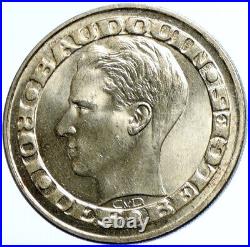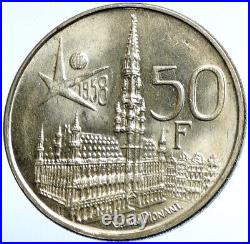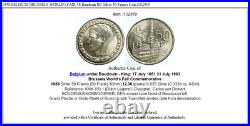



Item: i102919 Authentic Coin of. Under Baudouin – King: 17 July 1951 – 31 July 1993 Brussels World’s Fair Commemorative 1958 Silver 50 Francs (50 Frank) 30mm (12.30 grams) 0.835 Silver 0.3334 oz. Grand Plache or Grote Markt of Brussels with Town Hall divides date from denomination. Baudouin or Boudewijn (7 September 1930 – 31 July 1993) reigned as King of the Belgians, following his father’s abdication, from 1951 until his death in 1993. He was the eldest son of King Leopold III (1901-83) and his first wife, Princess Astrid of Sweden (1905-35). Because he had no children with his wife, Queen Fabiola of Belgium, the Crown passed to his younger brother, King Albert II of the Belgians (formerly Prince of Liège), following his death. He was a maternal first cousin of King Harald V of Norway, Princess Astrid of Norway, and Princess Ragnhild of Norway. Baudouin is the French form of his name, the form most commonly used outside Belgium; his Dutch name is Boudewijn. The English equivalent is Baldwin. Expo 58, also known as the Brussels World’s Fair (Dutch: Brusselse Wereldtentoonstelling, French: Exposition Universelle et Internationale de Bruxelles), was held from 17 April to 19 October 1958. It was the first major World’s Fair after World War II. The Town Hall of the City of Brussels municipality. Nearly 15,000 workers spent three years building the 2 km. (490 acres) site on the Heysel plateau, 7 kilometres (4.3 mi) northwest of central Brussels, Belgium. Many of the buildings were re-used from the Brussels International Exposition of 1935, which had been held on the same site. Every 25 years starting in 1855, Belgium had staged large national events to celebrate its national independence following the Belgian Revolution of 1830. However, the Belgian government under prime minister Achille Van Acker decided to forego celebrations in 1955 to have additional funding for the 1958 Expo. Expo 58 was the 11th World’s Fair hosted by Belgium, and the fifth in Brussels, following the fairs in 1888, 1897, 1910 and 1935. Since Expo 58, Belgium has not arranged any more world fairs. The site is best known for the Atomium, a giant model of a unit cell of an iron crystal (each sphere representing an atom). More than 41 million visitors visited the site, which was opened with a call for world peace and social and economic progress, issued by King Baudouin I. Notable exhibitions include the Philips Pavilion, where “Poème électronique”, commissioned specifically for the location, was played back from 425 loudspeakers, placed at specific points as designed by Iannis Xenakis, and Le Corbusier. Another exhibition at the Belgian pavilion was the Congolese village that some have branded a human zoo. Belgium, officially the Kingdom of Belgium, is a sovereign state in Western Europe. It is a small, densely populated country which covers an area of 30,528 square kilometres (11,787 sq mi) and has a population of about 11 million people. Straddling the cultural boundary between Germanic and Latin Europe, Belgium is home to two main linguistic groups: the Dutch-speaking, mostly Flemish community, which constitutes about 59% of the population, and the French-speaking, mostly Walloon population, which comprises 41% of all Belgians. Additionally, there is a small group of German-speakers who live in the East Cantons located around the High Fens area, and bordering Germany. Belgium is a federal constitutional monarchy with a parliamentary system of governance. It is divided into three regions and three communities, that exist next to each other. Its two largest regions are the Dutch-speaking region of Flanders in the north and the French-speaking southern region of Wallonia. The Brussels-Capital Region, officially bilingual, is a mostly French-speaking enclave within the Flemish Region. A German-speaking Community exists in eastern Wallonia. Belgium’s linguistic diversity and related political conflicts are reflected in its political history and complex system of government. Historically, Belgium, the Netherlands and Luxembourg were known as the Low Countries; it once covered a somewhat larger area than the current Benelux group of states. The region was called Belgica in Latin, after the Roman province of Gallia Belgica. From the end of the Middle Ages until the 17th century, the area of Belgium was a prosperous and cosmopolitan centre of commerce and culture. From the 16th century until the Belgian Revolution in 1830, when Belgium seceded from the Netherlands, the area of Belgium served as the battleground between many European powers, causing it to be dubbed the “Battlefield of Europe, ” a reputation strengthened by both world wars. Upon its independence, Belgium participated in the Industrial Revolution and, during the course of the 20th century, possessed a number of colonies in Africa. The second half of the 20th century was marked by rising tensions between the Dutch-speaking and the French-speaking citizens fueled by differences in language and the unequal economic development of Flanders and Wallonia. This continuing antagonism has led to several far-reaching reforms, resulting in a transition from a unitary to a federal arrangement during the period from 1970 to 1993. Despite the reforms, tensions between the groups remain; the formation of a coalition government took 18 months following the June 2010 federal election. Belgium is a founding member of the European Union, Eurozone, NATO, OECD and WTO, and a part of the trilateral Benelux Union. Its capital, Brussels, hosts several of the EU’s official seats as well as the headquarters of many major international organizations such as NATO. Belgium is also a part of the Schengen Area. Belgium is a developed country, with an advanced high-income economy and is categorized as “very high” in the Human Development Index. World-renowned expert numismatist, enthusiast, author and dealer in authentic ancient Greek, ancient Roman, ancient Byzantine, world coins & more. Ilya Zlobin is an independent individual who has a passion for coin collecting, research and understanding the importance of the historical context and significance all coins and objects represent. Send me a message about this and I can update your invoice should you want this method. Getting your order to you, quickly and securely is a top priority and is taken seriously here. Great care is taken in packaging and mailing every item securely and quickly. What is a certificate of authenticity and what guarantees do you give that the item is authentic? You will be very happy with what you get with the COA; a professional presentation of the coin, with all of the relevant information and a picture of the coin you saw in the listing. Additionally, the coin is inside it’s own protective coin flip (holder), with a 2×2 inch description of the coin matching the individual number on the COA. Whether your goal is to collect or give the item as a gift, coins presented like this could be more prized and valued higher than items that were not given such care and attention to. When should I leave feedback? Please don’t leave any negative feedbacks, as it happens sometimes that people rush to leave feedback before letting sufficient time for their order to arrive. The matter of fact is that any issues can be resolved, as reputation is most important to me. My goal is to provide superior products and quality of service. How and where do I learn more about collecting ancient coins? Visit the Guide on How to Use My Store. For on an overview about using my store, with additional information and links to all other parts of my store which may include educational information on topics you are looking for.

